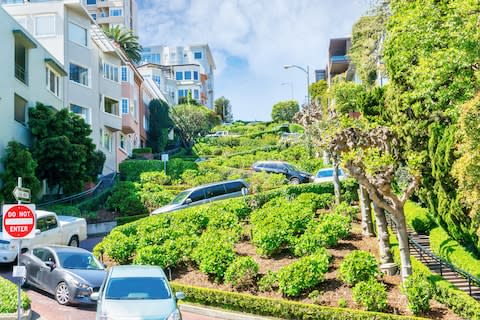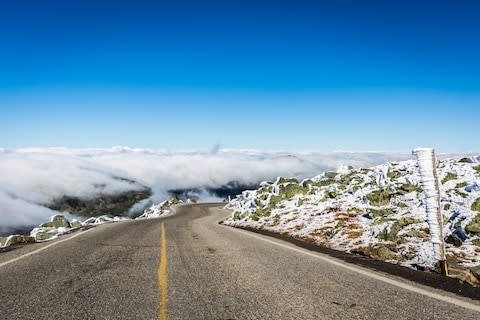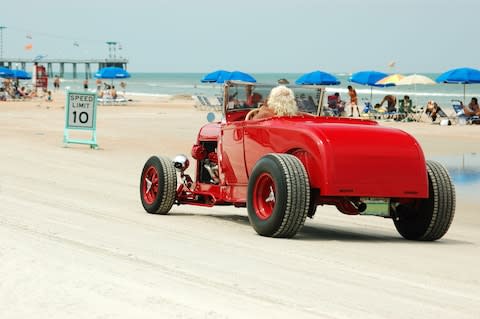The curious case of Lombard Street, San Francisco's overcrowded oddity

Some four and a half years ago, I climbed into rental a car on a warm afternoon. I pulled a seatbelt - scorching to the touch, because the vehicle had been parked in direct sunlight - across my chest. And then I headed off through the petrol fumes, tyre squeal and general commotion of a major American metropolis, in search of a traffic jam.
I did so in spite of it being a lovely late-summer day in a city which boasts one of the most picturesque settings anywhere on the planet; a conurbation that gleams on the cusp of the Pacific, giant bridges which fill up Instagram feeds criss-crossing its waterways.
I did so despite there being many better things to do in a place that is awash with historic sites, excellent art museums and first-rate dining options. And I did so because I hadn't done something that a lot of people have done - and I wanted to make sure I hadn't been missing out on a life-affirming encounter; an experience that might merit inclusion in my death-bed flashback reel.
I was wrong.
By the time I had queued 15 minutes to reach the proper start-point of this grand odyssey, I knew I had made a mistake. The temperature had risen, the car's air-conditioning was puffing noisily, and I had been trapped so closely between the same two sedans for the duration of the wait that I feared all three vehicles might become welded together in the heat.

Then came the brief moments of truth - some half a minute of inching slowly downhill, bumper to bumper (or, this being the USA, fender to fender), foot largely clamped to the brake, every few seconds requiring a hard wrench of the wheel, every one of these turns underpinned by a fear of scratching the paintwork on one of the low walls on either side of the camber. There was no chance to pause and enjoy the scenery. If anything, it felt (loosely) like being back in the Birmingham suburbs, re-doing part of my driving test. Only with 50 other cars in attendance - and, admittedly, a view that a rainy day in Wednesbury has never been able to match.
What was I doing, and where, and why? The location answers all three questions.
For this was Lombard Street in San Francisco. Or, to be more precise, it was the single-block section of it, in the Russian Hill district, where the gradient is so sharp that the road tackles it in eight tight corkscrew curves of red-brick paving.
To steer a vehicle down it is the antithesis of the cinematic cop-car chases - enshrined in movie folklore by the 1968 Steve McQueen classic Bullitt - that have become the main popular-culture image of driving in California's fourth biggest city. It requires not reckless velocity and smoking-rubber abandon, but care, diligence and patience.
Yet for all this, it has become a fundamental part of the tourist trail at the heart of this much-loved destination. "The Crookedest Street in the World" welcomes more than two million visitors a year - many of them behind the wheel, at an average of 250 cars every hour.

This, you might think, is too much and too many - and increasingly, the city thinks so too. Plans are afoot to charge visitors for the privilege of trundling down what is less than a quarter-mile of highway. Local legislation has been proposed which would make the segment of Lombard Street between Hyde Street and Leavenworth Street a toll road - with a possible access fee of US$10 (£7.70). The proposal is designed to protect what is, after all, a residential zone, reducing the number of cars, and lowering pollution levels as vehicles wait in line for their turn - sometimes to as far back as Van Ness Avenue, three blocks to the west.
"We must implement a system which enables both residents and visitors to enjoy the Crookedest Street in the World," Phil Ting, a San Francisco councillor sponsoring the bill said last week. "The cars really impact the neighbourhood because they line up, they back up, they are sitting idling," added Greg Brundage, president of the Lombard Hill Improvement Association." A toll system, possibly requring prior reservations online, could come into force as soon as next year.
Having been part of the problem with my 5mph foray down Lombard Street in 2014, I'm aware that it's a bit rich of me to attempt to be part of the solution. But I would go further and exclude all cars from this Californian curiosity - with the exception, obviously, of those who live upon it. It must be immensely frustrating to open your front door to see - for the thousandth day in succession - a conga-line of 4WDs going through the motions outside. And while nobody, to resort to the cliche, has forced the residents of "the Crookedest Street in the World" to put down roots where they have, they might equally expect not to have to live in something akin to a traffic amusement park.
It is not as if anyone would lose a great deal. As I've written above, there is no enormous excitement to slaloming - very slowly - through these eight switchbacks. There is no time to "enjoy the ride", you cannot really look up to appreciate the cityscape, and if speed thrills are your thing, you are in the wrong place entirely.
If anything, a ban on vehicles would enhance the experience, allowing people to admire the vista - gazing east towards the Coit Tower - without the risk of being squashed by a saloon. Nor would closing the road to non-locals stop anyone paying a visit. There are pavements on both sides of the camber - from which all those Instagram photos tend to be taken anyway.
But then, many would argue that this would be sacrilege. Not only was the hairpin section of Lombard Street crafted with drivers in mind, its genesis dates to the first years of the motor car - a period of promise and optimism that was curtailed by the Wall Street Crash and the onset of the Second World War; a golden era which is sacred in American folklore.
The slope-road was constructed in 1922, when San Francisco was still rebuilding in the wake of the devastating earthquake of 1906. It was a clever alliance between geography and engineering, allowing residents the luxury of driving, to their doorsteps, cars that - fresh out of the fledgling factories of Detroit, all early technology and clunky parts - could otherwise not cope with Russian Hill's 27-degree gradient. It was not meant to greet a new set of wheels every 15 seconds, and its designers could never have envisaged that it would. But some would say that the principle remains.
A ban on vehicle entry is never likely to happen. Not only would a toll system be both a money-spinner and a reasonable compromise - but America has a track record when it comes to charging extra for popular and spectacular stretches of asphalt.

Witness the Mount Washington Auto Road in New Hampshire, which winds 7.2 miles to the roof of what is the tallest peak in New England ($31/£24 for a car and a single driver; mtwashingtonautoroad.com) - and Whiteface Veterans' Memorial Highway, which performs a similar role as it curls to the top of the fifth tallest peak in New York state ($11/£8.50; whiteface.com/activities/whiteface-veterans-memorial-highway). Then there is 17-Mile Drive, which traces the Californian edge of the landmass, winding around the fabled Pebble Beach golf course on the Monterey Peninsula. A date with its curves on the flank of the Pacific costs $10.50/£8 per vehicle (pebblebeach.com/17-mile-drive).

Whether or not San Francisco's most feted hairpins take a similar approach in the near future, they leave Lombard Street as one of America's most idiosyncratic roads. Its camera-calling steepness where it battles Russian Hill is not evenly replicated along its near three-mile length. Indeed, for a third of its journey across Downtown San Francisco, it is part of US Route 101 - the highway which courses 1,540 miles, south to north, up much of the western flank of the USA (between Los Angeles and the top end of Washington State). In others, the San Franciscan terrain is so unwelcoming that the city-planners abandoned the challenge entirely. There is a one-block gap where the road has to circumvent Telegraph Hill - directly underneath the Coit Tower. And so it swerves to the south-east, becoming Telegraph Hill Boulevard - before "Lombard Street" magically reappears on the other side of the bluff.
It is partly this inconsistency which has made it a silver-screen icon. Portions of Lombard Street (although not the hairpins) appear below soaring wheels and roaring engines in Bullitt - while it also shows its face (as, of course, does the Coit Tower) in Alfred Hitchcock's 1958 masterpiece Vertigo.
Three other places that might be better car-free
Richmond Park (UK)
If you have ever had the tranquility of an afternoon in London's largest royal park (royalparks.org.uk/parks/richmond-park) interrupted by the roar of an engine, you will not have been alone in wondering why cars are still allowed to drive across an oasis where deer roam. The Tamsin Trail - which provides a seven-mile circular route around the park, and is designed for cyclists and hikers - offers a refuge of sorts.

Timanfaya National Park (Spain)
Pinned to the north-west flank of Lanzarote, Timanfaya National Park is a magma-fried wonderland (gobiernodecanarias.org/parquesnacionalesdecanarias/en/Timanfaya). It is also a Unesco-designated biosphere reserve where the results of the volcanic eruptions which shook the easternmost Canary Island between 1730 and 1736 are still spectacular in their rawness. Here is an otherworldly landscape, all cracked peaks and plains of congealed basalt. But it could use a complete re-think on how it is accessed. At the moment, vehicles queue through lava fields to a car park that is far too small for the number of visitors - while tours of the core of the park are only available on large, dilapidated coaches that are too cumbersome for the roads they are forced to navigate.

Daytona Beach (USA)
If you think that there are many things you can do on a beach, but driving should not be one of them, then you may wish to steer clear of this city on Florida's Atlantic flank. Not that you will find many people who agree with you in Daytona Beach. The fact that cars are allowed to trundle along the sands (for a fee of $20/£15 per vehicle per day) is one of the resort's main selling-points (see daytonabeach.com/things-to-do/the-beach/driving). A speed limit of 10mph is in place, but - depending on your perspective - having to look both ways for traffic as you take your children down to the water for a paddle does make a day by the ocean less relaxing than it might be.


